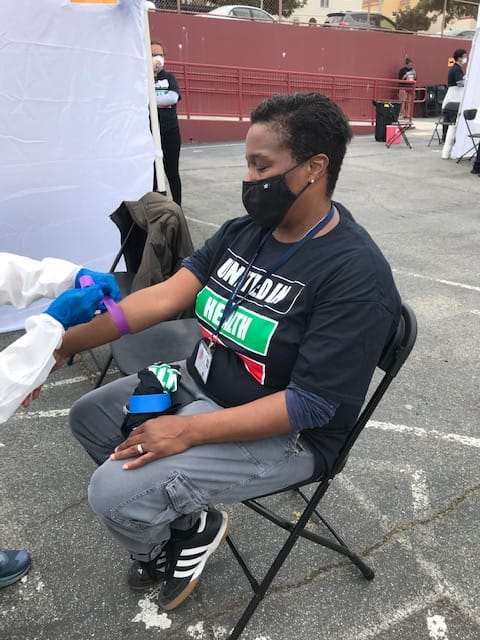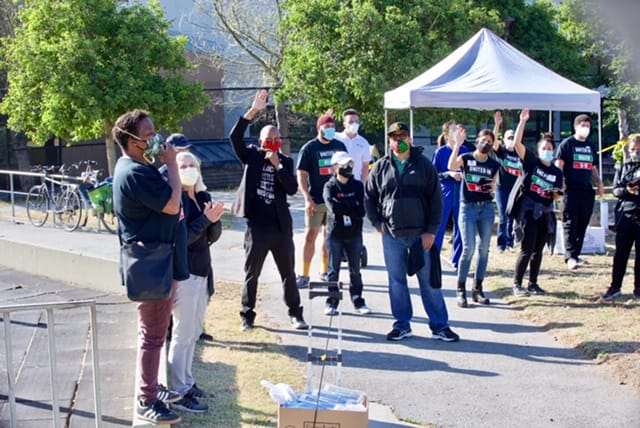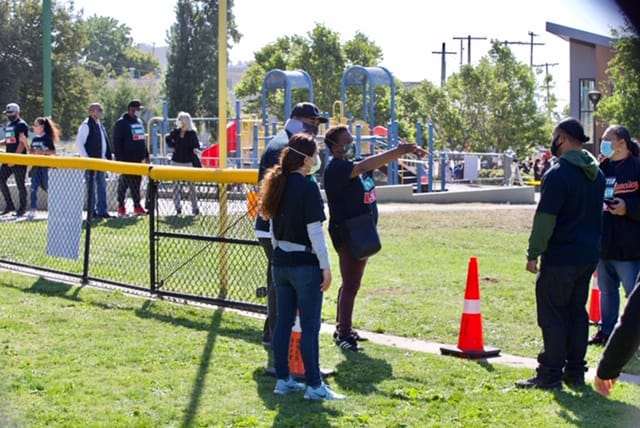
by JR Valrey, Black New World Journalists Society
Dr. Kim Rhoads, MD, MS, MPH, is an associate professor of epidemiology and biostatistics at the University of California, San Francisco (UCSF); director of the Office of Community Engagement at UCSF; and member of the COVID-19 Equity Task Forces in both San Francisco and Alameda County.
She has been holding the frontline in Frisco, with her boots on the ground, in the war against the COVID-19 virus in Hunters Point, in the southeast section of the city.
According to The New York Times, in late June, COVID-19 related deaths in the U.S. reached 124,000 with a total 2.4 million confirmed infections. California alone reported over 200,000 confirmed cases of COVID-19, with close to 6,000 deaths. According to the University of Washington’s Institute for Health Metrics and Evaluation, projections expect 15,100 more deaths in California by Oct. 1, a 170 percent increase from the current death toll.
Robert Redfield, the director of the Centers for Disease Control and Prevention, estimated that the actual number of COVID-19 cases is as many as 10 times more than already detected by tests in the state. That would equal 2 million people infected, or 5 percent of the total population of California. Currently, more than 4,240 people hospitalized in California tested positive for the virus. So COVID-19 is a real thing.
I’m interviewing Dr. Kim Rhoads for an educated opinion about the COVID-19 pandemic and quarantine. We’ve heard from everybody else in the corporate media; now it’s time for us to hear from a local Black medical professional who is actively engaged in the war between this virus and the Black community. We know that it is an uphill battle, but it is one we must embark on.
The Black community, with good reason, does not trust the white medical establishment in this country, due to the horrible atrocities committed against us under the veil of the medical field since its inception. This is the first in a series of interviews that will give the Black community insight into what we are dealing with and clear up any misconceptions we may have.
Please read Dr. Kim Rhoads’ exclusive Q&A as she explains what is going on in this very historic time.
JR Valrey: Now that California is opening back up, is COVID-19 still a threat? Was the decision to reopen the state for business a public health decision or an economic one?
Dr. Kim Rhoads: Yes, COVID-19 is still a threat. Anywhere the virus is present, it is a threat. It is relatively easy to transmit because many who are infected don’t have any symptoms. They may spread the virus to others before they find out that they are infected.
I was not in the circles where the decision was made, so I cannot speak to the second part of the question.
JR Valrey: How accurate are the COVID-19 tests that are being used in San Francisco?
Dr. Kim Rhoads: There are different tests being used across the city and county of San Francisco. I cannot speak to the accuracy of any labs being done outside of UCSF. As a general rule, Polymerase Chain Reaction (PCR), the test we use to detect the presence of genetic material from the virus, is highly specific. That means if the test is positive, it is positive for coronavirus, not, for example, the flu.
The sensitivity, or the rate at which PCR picks up virus when it is present, can vary depending on the length of time someone has been infected and the amount of virus in their system. The rates of picking up the virus are the highest when people are several days to a week into the infection.
JR Valrey: What does COVID-19 do to the body in the most severe cases?
Dr. Kim Rhoads: COVID-19 can affect every bodily organ. However, the most common profile includes severe inflammation in the small air sacs in the lungs causing a very severe form of pneumonia in both lungs. The inflammation thickens the normally thin wall of the air sacs and reduces the ability of the oxygen you breathe in to pass from the air sac into the bloodstream.
This gives people hunger for air, or shortness of breath, and may require patients to be placed on a breathing machine (ventilator) in the intensive care unit. The problem is that the breathing machine is simply introducing more oxygen into the system, but because of the mechanical blockage by the thickened walls of the air sacs, the breathing machine may be ineffective.
We are coming to understand that the novel coronavirus also causes inflammation in the blood vessels which can cause both bleeding and blockage of the blood vessel. Blockage of the vessel causes damage and injury to the affected organ; for example, in the kidney, this can cause kidney failure requiring dialysis; and in the brain, it can cause strokes, even in a young person. This is partly how COVID-19 can cause multiple organ failure and death.
JR Valrey: Do masks do more harm than good in this pandemic environment?
Dr. Kim Rhoads: Masks significantly reduce the rate of transmission of COVID-19. At the beginning of the pandemic, the messaging was confusing.
In mid-March, we – the Centers for Disease Control, public health officials and medical professionals – were telling people not to bother with masks because they do not reduce the rate of transmission. A June 15, 2020, Business Insider article reports that the original mask recommendation from the federal government was made due to concern about a shortage of personal protective equipment (PPE).
. . . with COVID-19, it’s going to take the community to save the community.
The other part of the confusion is cultural. In America, we think of health as an individual level effort. COVID-19 is a public health problem which means that health depends on everyone working together. The current recommendation to wear a mask is not to protect YOU, it is to protect EVERYONE ELSE.
In addition, facial covering has different implications for different communities, especially Black men who may be seen as suspicious while wearing a mask. This is the result of systemic racism, not the mask itself. My hope is that this interpretation of mask wearing will subside as police receive long overdue scrutiny for profiling and brutalizing Black people, and as we come to understand that the virus will be with us for some time and masks are here for the long run.
JR Valrey: Have you seen a spike in COVID-19 infections over the last few weeks due to the many weeks of protest and rebellion throughout San Francisco and the Bay Area?
Dr. Kim Rhoads: With the recent spikes in cases across the state – California just posted a record breaking 7,000+ single day increase in the number of cases – the timing does suggest that protests may be contributing. I have not yet seen any modelling that directly implicates these marches. However, given the inability to social distance in a protest, we should expect to see this impact in the coming weeks.
JR Valrey: What role have you been playing on the frontline against COVID-19?
Dr. Kim Rhoads: Over the past five weeks, I have been working with community partners – Rafiki Coalition, Bayview Hunters Point Community Advocates, Wise Health, Young Community Developers, J & J Community Resource Center and the Samoan Community Development Center – and local influencers like Kevin Epps, AJ Burleson and Damien Posey, to increase awareness, testing and response in the Southeast sector of San Francisco.

I have had the good fortune to meet and work with District 10 Supervisor Shamann Walton and other institutional partners at the San Francisco Department of Public Health (SFDPH) and the San Francisco Human Rights Commission. I am also part of a number of COVID-19 equity task forces in both San Francisco and Alameda County/Oakland. I give community talks about COVID-19 and organize lectures by other UCSF faculty members for our community partners about the pandemic.
The most rewarding part of the work is having the opportunity to identify community assets and figure out efficient ways to link them together. To adapt a phrase from United Playaz, with COVID-19, it’s going to take the community to save the community. The mass testing effort, community organizing and mobilization was good practice for the work that diverse communities are going to have to do together in order to dismantle the social inequities that the disease, among other recent events, has unmasked – no pun intended.
JR Valrey: How can San Francisco and the Bay defeat COVID? What do you recommend?
Dr. Kim Rhoads: As there is no vaccine and no treatment for COVID-19, the virus must be eliminated from society. The only path to get the virus out of the community, city, county and Bay Area is to test. We must find the people who are carrying the virus and support them to isolate and quarantine. Then do contact tracing to find other cases, and repeat.
During the isolation period, if the symptoms are mild, people can recover at home, which will help them avoid spreading the virus to other people. The countries that have done the best job of beating the novel coronavirus have done so through widespread testing and aggressive response with isolation, quarantine and aggressive contact tracing. Many of them, such as New Zealand, Australia, Iceland and South Korea, have a strong public health-contact tracing and a coherent social safety net.
Thus, the risk of losing employment for needing to take two weeks off are lower in these countries than what we are seeing in the U.S. Imagine if everyone who was carrying the virus could isolate and quarantine for 10 days or two weeks and resolve the illness without having to worry about the individual economic impact?
JR Valrey: Is testing as available as it should be for the Black communities of the Bay Area?
Dr. Kim Rhoads: Testing is not as available as it should be to anyone in the U.S. It is baffling to me, because this is a global pandemic. That means everyone, literally everyone, is impacted.

But nonetheless, getting a test right now often requires symptoms or known exposure or any other specific qualifying characteristics. Testing strategies are discussed as needing to be “targeted,” which exposes the unspoken agreement that tests need to be rationed.
I would argue that anytime something in healthcare is rationed, Black people are less likely to get access. I know this is cynical, but it’s difficult to think of a health care example where that is not true. Consider organ transplantation.
JR Valrey: What will be some of the lasting effects of this virus on society? Will life ever return to pre-COVID behavior in a post-COVID world?
Dr. Kim Rhoads: I do not see things going back to normal. So-called “normal” is how we got to where we are now. Social inequity has exaggerated the impacts of COVID on Black and Brown communities and those in low resource settings.
If nothing else, the pandemic is showing us that we have to protect each other rather than thinking only of ourselves.
Coronavirus is trying to show us that we are living our lives in a potentially destructive way. This includes our dependence on health care for health – rather than prevention and public health – and the fact that health systems generate revenue from illness. The virus is also showing us how much we need other human beings – social distancing is hard! – which I hope will help people break out of their device-induced bubbles and get back to direct human interactions.
If nothing else, the pandemic is showing us that we have to protect each other rather than thinking only of ourselves. So although I do not believe things will be going back to “normal” anytime soon, I am hopeful that the changes that come from this pandemic will be for the better, hopefully destroying the old “normal” that consistently advantages some groups over others.
The economic destruction the virus is going to cause in this country may drive us to work together because the things we have in common – needing support – will outweigh the differences used to justify and maintain social inequity. I’m largely talking about race here.
JR Valrey: As a doctor, how do you see the school environment changing post-COVID?
Dr. Kim Rhoads: I am not sure about this. I have heard that there may be cohorting of students and schedules that require some cohorts to stay home on certain days and to be on campus other days. I have also heard from friends – other parents – that some schools are looking at clear masks to help kids interpret non-verbal cues.
I really don’t think we know exactly what is going to be safe. But just like “reopening” economies, reopening schools is going to require robust testing, isolation and contact tracing work.
JR Valrey: As a doctor, do you see more pandemic-style viruses coming to the U.S. in the future?
Dr. Kim Rhoads: I do not have the expertise to comment on this.
JR Valrey: Is there anything about this virus that lead you to believe that this pandemic is man-made?
Dr. Kim Rhoads: No. There are some good articles that break down the genetic sequences of the virus and show its close homogeneity with other coronaviruses.
JR Valrey: Many people protested the quarantine or refused to quarantine. Do you think the government’s response to COVID-19 was blown out of proportion?
Dr. Kim Rhoads: Our federal government’s response has been lukewarm and underwhelming with respect to the seriousness of the pandemic. If we had a national shutdown in the beginning when there were fewer cases, we might be in a completely different place right now, instead of first and worst in the world with the most COVID-19 related deaths.
JR Valrey: How do you feel about how Mayor London Breed is piloting San Francisco through this biological muck?
Dr. Kim Rhoads: I was very proud that the Bay Area was the first in the country to shelter in place. I happen to be in the Department of Epidemiology and Biostatistics at UCSF, with some of the premier thought leaders in managing infectious disease pandemics, so I am a bit biased. The Bay Area has an incredibly competent public health, health care and basic science research leadership, which provides sound counsel to all our local elected officials, if they want it. So there is no surprise that our area is leading the way in using data to guide our response.
JR Valrey: What can we do to support your work? Is there a way that people can follow your work?
Dr. Kim Rhoades: Take COVID-19 seriously. Get tested if you have the opportunity. Many of the people who have tested positive in these UCSF mass testing initiatives have had no symptoms. Just because you feel good doesn’t mean you don’t have coronavirus. Advocate for testing for everyone, regardless of symptoms; it is a global pandemic after all.
Finally, wear a mask, wash your hands, don’t touch your face and know that everything you are doing is for others and not just for yourself.
People can follow me on Twitter @kfrhoads (riffing on health equity) or @ucsfcancer_oce.
The People’s Minister of Information JR Valrey, journalist, author, filmmaker and founder of the Black New World Journalists Society, can be reached at blockreportradio@gmail.com or on Facebook. Visit www.youtube.com/blockreporttv. All stories written about COVID-19 were partially made possible by the Akonadi Fund #SoLoveCanWin.





